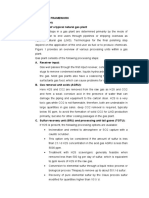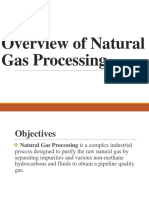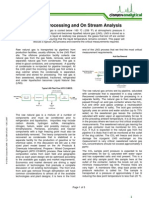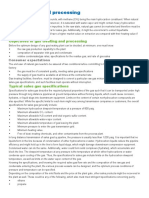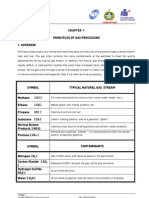End User
End User
Uploaded by
Kartikeya SachanCopyright:
Available Formats
End User
End User
Uploaded by
Kartikeya SachanOriginal Description:
Original Title
Copyright
Available Formats
Share this document
Did you find this document useful?
Is this content inappropriate?
Copyright:
Available Formats
End User
End User
Uploaded by
Kartikeya SachanCopyright:
Available Formats
What is processing of Natural gas?
mechanism through which contaminants are removed and components of interest (VAP) are recovered. Why processing is required? Required to make the gas compatible with the requirements of pipe line transportation as well as conforming to the specifications of end user.
Oil and Condensate Removal Water Removal Separation of Natural Gas Liquids Sulfur and Carbon Dioxide Removal
Raw natural gas comes from three types of wells: oil well(associated gas'.)s, gas wells, and condensate wells.( non associated gas'.)
principally ethane, propane, butane, and pentanes. In addition, raw natural gas contains water vapor, hydrogen sulfide (H2S), carbon dioxide, helium, nitrogen, and other compounds. Natural gas processing consists of separating all of the various hydrocarbons and fluids from the pure natural gas, to produce what is known as 'pipeline quality' dry natural gas.
USES fuel for residential domestic major source for electricity generation to produce hydrogen major feedstock for the production of ammonia, via the Haber process, for use in fertilizer production.manufacture of fabrics, glass, steel, plastics, paint, and other products like Heavy water. CNG (compressed natural gas) is natural gas compressed to high pressures at ambient temperatures. LNG (Liquefied natural gas) is natural gas liquefied at -161 OC at atmospheric pressure which contains mainly methane, ethane and propane and minor C4. It does not contain CO2 (<1 ppm). OngcONGC has LPG extraction plants at Ankleswar, Gandhar and Hazira in Gujarat, Uran in Maharashtra Asias largest sour gas treatment plant of ONGC at Hazira is a massive stateofart technology plant where around 45 million M3/ day sour gas and 9,000 M3/day sour (gas) condensate are processed to remove H2S and extract C3, LPG, ARN, Kerosene/ATF, and HSD. ONGCs first gas process plant at Uran produces C2, C3, LPG and ARN. ONGC has also mini refinery plants at Tatipaka in Andhra Pradesh and Karaikal in Tamil Nadu which produces ARN, Kerosene and HSD ONGC constructed a C2 and C3 extraction plant at Dahej which uses LNG as feed stock using Lindes process in which advantage is taken of the cryogenic temperature of LNG (~160OC) in receipt
OVERALL NATURAL GAS PROCESSING DESCRIPTION (with reference to HAZIRA)
process about 42 MMSCMD of sour gas and associated condensate set up under Phase-I, II, III and III A. The processing facilities at Hazira consist of Gas Sweetening, Dehydration, Dew Point Depression, Sulphur Recovery, and Condensate Fractionation Units. The complex has an LPG recovery unit to process 5.3 MMSCMD of Sweetened Gas. The lean Gas from the LPG unit is supplied to IPCL Dahej for C2-C3 extraction. The remaining Gas of about approx. 35 MMSCMD
is supplied to GAIL through the HBJ pipeline The gas after C2-C3 extraction is routed back to Hazira for supply to Local Consumers viz, KRIBHCO, ESSAR, GGCL,RIL etc. Various abbreviations used in the text are GSU- Gas sweetening Unit CFU- Condensate Fractionation Unit GDU- Gas Dehydration Unit DPD- Dew Point Depression Unit Haziramaintain down stream pressures at a preset value (normally set at 50-60 Kg/Cm2) water, oil, and NGL removalThe two-phase flow is received in the Slug Catcher, where the gas and condensate streams are separated. The gas is filtered, metered and sent to the GSU plants for further processing. Sulfur and Carbon dioxide removal.. 2.0 GAS SWEETENING UNIT This natural gas, because of the rotten smell provided by its sulfur content(due to H2S), is commonly called 'sour gas. Sour gas is undesirable extremely harmful, even lethal, to breathe extremely corrosive. sulfur that exists in natural gas stream can be extracted and marketed on its own.
the gas is usually considered sour if the hydrogen sulfide content exceeds 5.7 milligrams of H2S(5.7 ppm) per cubic meter of natural gas. The process for removing hydrogen sulfide from sour gas is commonly referred to as 'sweetening' the gas. H2S reacts to give amine hydrosulfide: H2S + R2NH ------HS - , R2NH2 CO2 can react directly with amine to form an amine carbonate: CO2 + 2R2NH ------R2NCOO- , R2NH2
CO2 + H2O <------H2CO3 CO2 + HO- <-------------HCO3 These acids then react with the amine to form amine bicarbonate (HCO3,RNH2+) and amine carbonate (CO2, (R2NH2+)2).
ProcessAmine solutions(methyl diethanol amine, 480 gm/litre)) are used to remove the hydrogen sulphide by amine absorption process.
PROCESS OBJECTIVES: To reduce the H2S content of sour gas (received from offshore & CFU off-gas) to 5 ppmv (max) (Acceptable level of H2S for pipeline transportation by M/s. GAlL) & 329 at the same time, to limit the CO2 Co-absorption to the minimum required and in any case, to not more than 32%.
3.0 GAS DEHYDRATION UNIT(GDU)The removal of water from sweet gas is made by contacting the gas with a triethylene glycol(TEG) solution. Due to their hygroscopicity, glycols are widely used for this purpose. The hygroscopicity is directly related to the solution concentration. So water vapor will be absorbed by a glycol solution as long as the partial pressure of the water in the vapor phase exceeds the water vapor pressure of the solution.. the molecular compatibility of the couple solvent-solute plays an important role. So the greater the molecular attraction between solvent and solute, the lower the vapor pressure of the water. In liquid state, water is highly associated through hydrogen bonds. the required specification is 85kg of water/million Nm3 of gas. DEW POINT DEPRESSION UNIT(DPD) Objective- to lowering the gas temperature well below the minimum temperature which the gas may attain in the HBJ pipeline.expected 11*C
You might also like
- Fire Service Manual - Volume 2 - Fire Service Operations - Petrochemical Incidents - 0 PDFDocument72 pagesFire Service Manual - Volume 2 - Fire Service Operations - Petrochemical Incidents - 0 PDFFpe Sygma100% (1)
- Dangote CPPDocument161 pagesDangote CPPSarah Frazier100% (1)
- CO2 Recovery Plant, NFCL, Andhra Pradesh (India)Document9 pagesCO2 Recovery Plant, NFCL, Andhra Pradesh (India)Sanjiv ChNo ratings yet
- Biogas Plant: Biogas Digester Design, Gas Production and PurificationFrom EverandBiogas Plant: Biogas Digester Design, Gas Production and PurificationRating: 3 out of 5 stars3/5 (1)
- Natural Gas ProcessingDocument35 pagesNatural Gas ProcessingAleem AhmedNo ratings yet
- Selection of Technologies For Gas Plant NaturalDocument15 pagesSelection of Technologies For Gas Plant NaturaljxlNo ratings yet
- Intro Natural Gas ProcessingDocument12 pagesIntro Natural Gas ProcessingVishalIndrapuriNo ratings yet
- Subject: Gas Processing PresentationDocument20 pagesSubject: Gas Processing PresentationUsama JahangirNo ratings yet
- Gas Processing CourseDocument235 pagesGas Processing CourseIbraheem ElBakry90% (10)
- Natural-Gas Processing Is A ComplexDocument7 pagesNatural-Gas Processing Is A ComplexstephanoupolusNo ratings yet
- LPGDocument13 pagesLPGsoheilkhosh3311No ratings yet
- Oil and Gas IndustryDocument6 pagesOil and Gas IndustrykarthickNo ratings yet
- Gas TreatmentDocument60 pagesGas TreatmentMusab AhmedNo ratings yet
- Gas SweeteningDocument3 pagesGas SweeteningAleem AhmedNo ratings yet
- Natural-Gas Processing Is A Complex Industrial Process Designed To Clean Raw Natural Gas byDocument4 pagesNatural-Gas Processing Is A Complex Industrial Process Designed To Clean Raw Natural Gas byLavenia Alou MagnoNo ratings yet
- Overview of Gas ProcessingDocument74 pagesOverview of Gas Processinghoangduy7696100% (1)
- Acid Gas RemovalDocument18 pagesAcid Gas RemovalKailash NarainNo ratings yet
- NGDocument23 pagesNGEngr. Md. Tipu SultanNo ratings yet
- Chapter 2Document7 pagesChapter 2pragati agrawalNo ratings yet
- Student Lecture 11 Field Processing and Treatment of Natural GasDocument38 pagesStudent Lecture 11 Field Processing and Treatment of Natural GasAjaykumarNo ratings yet
- SulphurRecovery PDFDocument22 pagesSulphurRecovery PDFfatamorgganaNo ratings yet
- Hydrodesulfurization Unit For Natural Gas Condensate: Simulation Based On Aspen Plus SoftwareDocument7 pagesHydrodesulfurization Unit For Natural Gas Condensate: Simulation Based On Aspen Plus SoftwareRuben MaciasNo ratings yet
- LNG Processing and On Stream Analysis: Typical LNG Plant Flow (APCI C3/MCR)Document5 pagesLNG Processing and On Stream Analysis: Typical LNG Plant Flow (APCI C3/MCR)Semana MhNo ratings yet
- Intro-Natural Gas ProcessingDocument45 pagesIntro-Natural Gas ProcessingJaimin PrajapatiNo ratings yet
- Gas Pre TreatmentDocument12 pagesGas Pre TreatmentAnonymous bHh1L1100% (4)
- Gas Treating and ProcessingDocument3 pagesGas Treating and ProcessingRoger AP100% (1)
- Natural Gas Cleaning and TreatmentDocument13 pagesNatural Gas Cleaning and Treatmentvamsix100% (1)
- HDTB SectorDocument7 pagesHDTB SectorPartha AichNo ratings yet
- Natural Gas ProcessingDocument5 pagesNatural Gas ProcessingĐoàn TrangNo ratings yet
- _5_Document8 pages_5_mohammedxro0No ratings yet
- Litreture ReviewDocument11 pagesLitreture Reviewpeteng.moh.omarNo ratings yet
- Gas Treatment ProcessDocument6 pagesGas Treatment ProcessArham NaveedNo ratings yet
- Sour Gas Processing PDFDocument1 pageSour Gas Processing PDFElavarasan Ramalingam0% (1)
- Petrochemicals From Shale Gas: CHL 112 - Term ReportDocument9 pagesPetrochemicals From Shale Gas: CHL 112 - Term ReportBhanu Mittal100% (1)
- CHAPTER 4 Jan 2022 Natural Gas 2Document67 pagesCHAPTER 4 Jan 2022 Natural Gas 2Intan HoranNo ratings yet
- Gas Processing Fundamentals Manual1Document12 pagesGas Processing Fundamentals Manual1Ahmed Khamees ShatlaNo ratings yet
- Energy Engineering 2Document32 pagesEnergy Engineering 2Usama SultanNo ratings yet
- Biogas Upgrading AND Utilisation: IEA BioenergyDocument20 pagesBiogas Upgrading AND Utilisation: IEA BioenergyilariofabbianNo ratings yet
- Simulation and Optimization of Natural Gas Sweetening PlantDocument16 pagesSimulation and Optimization of Natural Gas Sweetening PlantVõ Xuân QuảngNo ratings yet
- Supporting Functional Units in LNG PlantsDocument28 pagesSupporting Functional Units in LNG PlantsadityarajchikkalaNo ratings yet
- CP PC 2Document42 pagesCP PC 2Priyanka NagpureNo ratings yet
- Gas Treatment Processes-1Document17 pagesGas Treatment Processes-1m sohailNo ratings yet
- Natgas ProcessDocument20 pagesNatgas ProcessHarold AldayNo ratings yet
- Taylor CraigDocument11 pagesTaylor CraigPhani KumarNo ratings yet
- Natural Gas Sweetening Process DesignDocument13 pagesNatural Gas Sweetening Process DesignJeyakumar Raja100% (1)
- Hazira PlantDocument7 pagesHazira PlantRahul BhandurgeNo ratings yet
- Biogas Upgrader: Component Range AverageDocument4 pagesBiogas Upgrader: Component Range AverageBelega MihailNo ratings yet
- Engineering College Petroleum Department: Karbala UniversityDocument24 pagesEngineering College Petroleum Department: Karbala Universityabdo.amn.51188No ratings yet
- TEE 803 Introduction To CCT Lec 13 15Document16 pagesTEE 803 Introduction To CCT Lec 13 15Sami KhanNo ratings yet
- ADIP RefineryDocument2 pagesADIP RefineryVenkatesh Kumar RamanujamNo ratings yet
- Chapter 7 Natural Gas ProcessingDocument41 pagesChapter 7 Natural Gas ProcessingJagathisswary Satthi0% (1)
- Raw Nat GasDocument15 pagesRaw Nat GasamirlngNo ratings yet
- Amine Gas TreatingDocument3 pagesAmine Gas Treatinghmudassir_1No ratings yet
- Ppe AssDocument5 pagesPpe AssLouis Alfred MendrosNo ratings yet
- Aspen-HYSYS Simulation of Natural Gas Processing PlantDocument4 pagesAspen-HYSYS Simulation of Natural Gas Processing Plantsorincarmen88No ratings yet
- Clean Ironmaking and Steelmaking Processes: Efficient Technologies for Greenhouse Emissions AbatementFrom EverandClean Ironmaking and Steelmaking Processes: Efficient Technologies for Greenhouse Emissions AbatementNo ratings yet
- Natural Gas: Operations and Transport: A Handbook for Students of the Natural Gas IndustryFrom EverandNatural Gas: Operations and Transport: A Handbook for Students of the Natural Gas IndustryNo ratings yet
- Synthetic Natural Gas: From Coal, Dry Biomass, and Power-to-Gas ApplicationsFrom EverandSynthetic Natural Gas: From Coal, Dry Biomass, and Power-to-Gas ApplicationsTilman J. SchildhauerNo ratings yet
- Environmental Scenario in Indian Mining Industry - an OverviewFrom EverandEnvironmental Scenario in Indian Mining Industry - an OverviewNo ratings yet
- Laws of Chemical EnggDocument3 pagesLaws of Chemical EnggKartikeya SachanNo ratings yet
- OngcDocument12 pagesOngcKartikeya SachanNo ratings yet
- Design of Jet PumpsDocument11 pagesDesign of Jet PumpsKartikeya Sachan50% (2)
- Artificial Lift Methods ComparisonsDocument6 pagesArtificial Lift Methods ComparisonshamadahutpNo ratings yet
- 2 - Review - of - Reservoir - Fluid - Properties - PDFDocument77 pages2 - Review - of - Reservoir - Fluid - Properties - PDFjoreli100% (1)
- Drilling FluidDocument29 pagesDrilling FluidKartikeya Sachan100% (1)
- Resume AnubhavDocument2 pagesResume AnubhavKartikeya SachanNo ratings yet
- 4 BromoacetanilideDocument1 page4 BromoacetanilideradhikaNo ratings yet
- ARAMCO PTW Receiver's Qualification Exams.2 & AnswersDocument4 pagesARAMCO PTW Receiver's Qualification Exams.2 & AnswersMohamed rasheed100% (1)
- Publication 9 30888 310Document4 pagesPublication 9 30888 310mailsk123No ratings yet
- CHAPTER 8: The Chemistry of The AtmosphereDocument2 pagesCHAPTER 8: The Chemistry of The Atmospherecory kurdapyaNo ratings yet
- Wet H S Corrosion and Inhibition: Technical PaperDocument9 pagesWet H S Corrosion and Inhibition: Technical Papershahramm_gh6062No ratings yet
- CHE 310 Conversion / Degree of Completion: DefinitionDocument30 pagesCHE 310 Conversion / Degree of Completion: DefinitionNelson100% (1)
- Chapter 1.1 Introduction To Natural Gas EngineeringDocument27 pagesChapter 1.1 Introduction To Natural Gas EngineeringhugoNo ratings yet
- Diesel HygroscopicDocument3 pagesDiesel HygroscopicErlangga SatyawanNo ratings yet
- Indonesia: Offshore Mahakam Block and Attaka UnitDocument4 pagesIndonesia: Offshore Mahakam Block and Attaka UnitjiokoijikoNo ratings yet
- Writing and Balancing Chemical EquationsDocument4 pagesWriting and Balancing Chemical EquationsEmmarie MercadoNo ratings yet
- Fuel Properties of Hydrogen, Liquefied PetroleumDocument11 pagesFuel Properties of Hydrogen, Liquefied PetroleumTran Lam PhatNo ratings yet
- Air (TYS) Ashley MDL8D-2 I7ikrDocument12 pagesAir (TYS) Ashley MDL8D-2 I7ikrashleytham89No ratings yet
- Norma NP EN 1089-3Document15 pagesNorma NP EN 1089-3rrsantosNo ratings yet
- Luxerra BrochureDocument2 pagesLuxerra BrochureSaniya ShaikhNo ratings yet
- GTL WPSDocument6 pagesGTL WPSYoucef ChorfaNo ratings yet
- Ailesh White Paper 1 2023Document47 pagesAilesh White Paper 1 2023Aditya PurnomoNo ratings yet
- Report-Biogas and Syngas UpgradingDocument97 pagesReport-Biogas and Syngas UpgradingKhong Yu NengNo ratings yet
- Synthesis and Recrystallization of Dibenzalacetone: Experiment - 4Document2 pagesSynthesis and Recrystallization of Dibenzalacetone: Experiment - 4ARYAN CHAVANNo ratings yet
- CHM 112 Kinetics Practice Problems AnswersDocument14 pagesCHM 112 Kinetics Practice Problems AnswersHamzar MohammedNo ratings yet
- Concentration of Solutions NotesDocument5 pagesConcentration of Solutions NotesIonacer ViperNo ratings yet
- Ge Oil Gas Qatar 101703Document3 pagesGe Oil Gas Qatar 101703fery662002No ratings yet
- SM 4 Cylinders F5 - FR 1 A 71Document72 pagesSM 4 Cylinders F5 - FR 1 A 71Rached DouahchuaNo ratings yet
- English Data Sheets 7592 Abek1Document2 pagesEnglish Data Sheets 7592 Abek1vanjaNo ratings yet
- Physical Properties of Hydrocarbon Fluids: Physical Constants For Pure ComponentsDocument14 pagesPhysical Properties of Hydrocarbon Fluids: Physical Constants For Pure ComponentsAlia Damar ANo ratings yet
- Power Plant Chemistry Measurement Advancements OrpDocument10 pagesPower Plant Chemistry Measurement Advancements OrpdalveerchoudharyNo ratings yet
- Danfoss Eliminator With Replaceable Solid Core: Type DCRDocument16 pagesDanfoss Eliminator With Replaceable Solid Core: Type DCRGogaNo ratings yet
- FGSR Example Gas Emergency Escape PlanDocument36 pagesFGSR Example Gas Emergency Escape PlanAnonymous GfPSYi4nNo ratings yet
- Project Outlook 2023 30.12.2022Document10 pagesProject Outlook 2023 30.12.2022Ashish GuptaNo ratings yet





